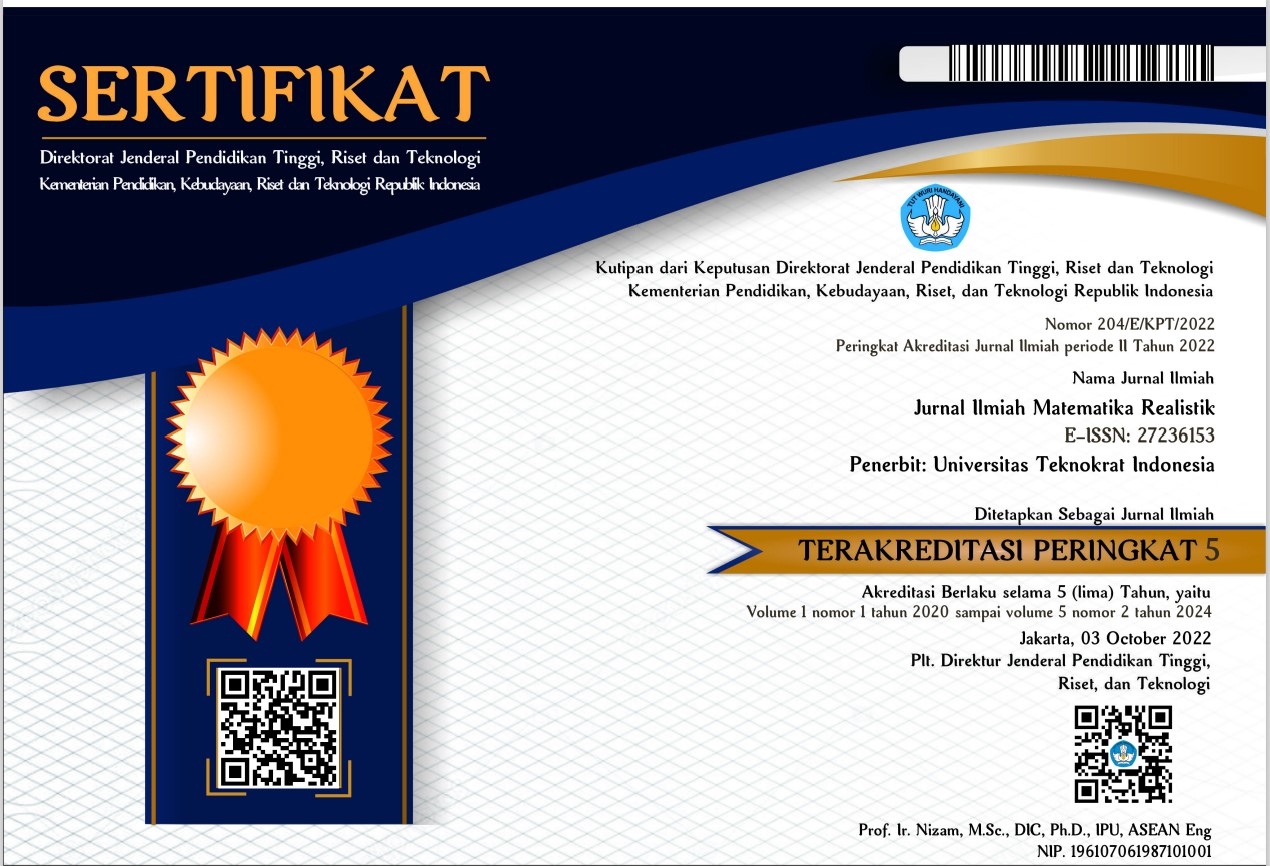PENERAPAN PECAHAN BERSAMBUNG DALAM MELAKUKAN APROKSIMASI BILANGAN IRASIONAL MENUJU BILANGAN RASIONAL
Abstract
Penelitian ini bertujuan untuk mencari aproksimasi rasional dari suatu bilangan irasional dengan ketelitian yang lebih akurat menggunakan pecahan bersambung. Metode yang digunakan pada penelitian ini berupa studi literatur mengenai sifat-sifat pada teori bilangan yang terkait dengan pecahan bersambung. Tahapan peneltian yang pertama yaitu dilakukan pengumpulan data terkait topik penelitian dari buku dan jurnal internasional melalui hasil penelusuran menggunakan internet pada Google Scholar. Kemudian dilakukan analisis data melalui tiga tahapan yaitu data reduction (reduksi data) yang merupakan proses penyederhanaan, pemfokusan dan abstraksi, data display (penyajian data) yaitu menyusun sekumpulan informasi agar sajian data tidak menyimpang dari pokok permasalahan dan conclution/verifying (penarikan kesimpulan) merupakan usaha untuk mencari atau memahami makna, keteraturan pola-pola penjelasan. Hasil dari penelitian ini adalah berupa pembahasan secara mendetail terkait dengan sifat-sifat dan penerapan pecahan bersambung yang dapat mendekati bilangan irasional menuju bilangan rasional dengan tingkat ketelitian yang diinginkan sehingga nantinya dapat diperoleh bilangan rasional yang mampu mendekati bilangan irasional dengan ketelitian yang tinggi. Kesimpulannya adalah setiap bilangan rasional dapat ditulis dalam bentuk PBSH dan setiap bilangan irasional dapat ditulis dalam bentuk PBST. Galat pada pendekatan pn/qn untuk x adalah <1/q2/n dan qn semakin membesar dengan membesarnya n. Semakin besar nilai n, konvergen pn/qn semakin mendekati x dan pendekatan rasional pn/qn untuk x lebih baik dari semua pecahan a/b untuk setiap penyebut positif b<qn.
Full Text:
PDFReferences
Aka, M., Breuillard, E., Rosenzweig, L., & Saxcé, d. N. (2018). Diophantine approximation on matrices and Lie groups. Geom. Funct. Anal. 28(1), 1–57. https://doi.org/10.1007/s00039-018-0436-0
Azarian, M. K. (2019). An Overview of Mathematical Contributions of Ghiyath al-Din Jamshid Al-Kashi [Kashani]. Mathematics Interdisciplinary Research, 4(1), 11-19. https://doi.org/10.22052/mir.2019.167225.1110
Cox, D., Ghosh, S., & Sultanow, E. (2021). The Farey Sequence and the Mertens Function. arXiv. https://doi.org/10.13140/RG.2.2.12856.26880
Dolgov, D.A. (2018). Polynomial Greatest Common Divisor as a Solution of System of Linear Equations. Lobachevskii J Math. 39(7), 985–991. https://doi.org/10.1134/S1995080218070090
Effinger, G., & Mullen, G. L. (2021). Elementary number theory. Boca Raton: CRC Press
Freud, R., & Gyarmati, E. (2020). Number theory (Vol. 48). Rhode Island: American Mathematical Soc.
Gallian, J. A. (2021). Contemporary abstract algebra (10th Edition). New York: Chapman and Hall/CRC.
Heil, C. (2019). Introduction to real analysis (Vol. 280). Switzerland: Springer.
Iliev, A., & Kyurkchiev, N. (2018). A Note on Euclidean and Extended Euclidean Algorithms for Greatest Common Divisor for Polynomials. International Journal of Pure and Applied Mathematics, 118(3), 713-721. https://doi.org/10.12732/ijpam.v118i3.18
Iliev, A., Kyurkchiev, N., & Rahnev, A. (2018). A New Improvement Euclidean Algorithm for Greatest Common Divisor. I. Neural, Parallel, and Scientific Computations, 26(3), 355-362. https://doi.org/10.12732/npsc.v26i3.10
Iliev, A., Kyurkchiev, N., & Rahnev, A. (2020). New Extended Algorithm for Finding Greatest Common Divisor. Neural, Parallel, and Scientific Computations, 28(1), 89-95. https://doi.org/10.12732/npsc.v28i1.10
Kim, D. H., & Liao, L. (2019). Dirichlet uniformly well-approximated numbers. International Mathematics Research Notices, 2019(24), 7691-7732. https://doi.org/10.48550/arXiv.1508.00520
Koukoulopoulos, D. (2021). Rational approximations of irrational numbers. arXiv:2109.11003. https://doi.org/10.48550/arXiv.2109.11003
Kowalski, E., & Soundararajan, K. (2021). Equidistribution from the Chinese remainder theorem. Advances in Mathematics, 385, 107776. https://doi.org/10.1016/j.aim.2021.107776
Manzilati, A. (2017). Metodologi Penelitian Kualitatif: Paradigma, Metode dan Aplikasi. Malang: UB Press.
Moe, K. S. M., & Win, T. (2018). Enhanced honey encryption algorithm for increasing message space against brute force attack. In 2018 15th international conference on electrical engineering/electronics, computer, telecommunications and information technology (ECTI-CON), 86-89. https://doi.org/10.1109/ECTICon.2018.862005
Rosenthal, D., Rosenthal, D., Rosenthal, P., Rosenthal, D., Rosenthal, D., & Rosenthal, P. (2018). The Euclidean Algorithm and Applications. A Readable Introduction to Real Mathematics, 49-61. https://doi.org/10.1007/978-3-030-00632-7_7
Schmidt, W. M.. (2022). On simultaneous Diophantine approximation. Monatsh Math. 198(3), 641-650. https://doi.org/10.1007/s00605-021-01661-2
Sukhoy, V., & Stoytchev, A. (2021). Formulas and algorithms for the length of a Farey sequence. Scientific reports, 11(1), 22218. https://doi.org/10.1038/s41598-021-99545-w
Wall, H. S. (2018). Analytic theory of continued fractions. New York: Courier Dover Publications.
Yansyari, N. (2019). Studi Literatur Tentang Hubungan Intensitas Penggunaan Media Sosial Dengan Kualitas Tidur Pada Remaja. Malang: UB Press.
Zhang, S., Xie, X., & Xu, Y. (2020). A brute-force black-box method to attack machine learning-based systems in cybersecurity. IEEE Access, 8, 128250-128263. https://doi.org/10.1109/ACCESS.2020.3008.
DOI: https://doi.org/10.33365/ji-mr.v4i1.2528
Refbacks
- There are currently no refbacks.

This work is licensed under a Creative Commons Attribution-ShareAlike 4.0 International License.
JI-MR is licensed under a Creative Commons Attribution-ShareAlike 4.0 International License.
Mathematics Education Department, Faculty of Arts and Education.
Universitas Teknokrat Indonesia
All rights reserved.







